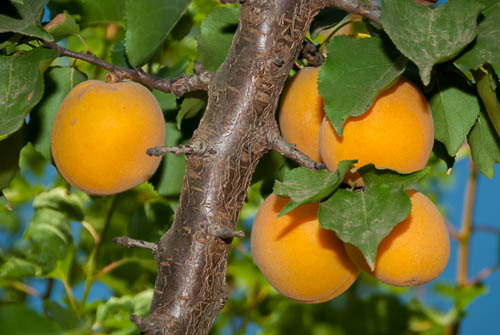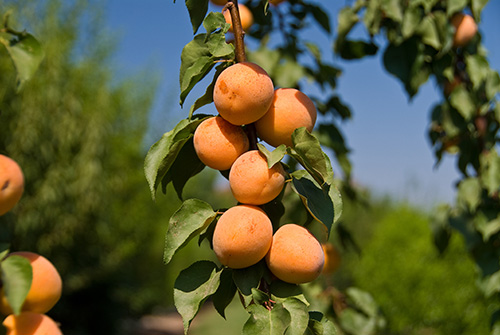Health Benefits of Apricots (Ume)

APRICOT- UME
Umes have been (almost exclusively) used by Asian cultures for centuries. Although it is very tasty pickled and juiced (and showy flowers), it is primarily consumed for the health benefits.
Umes are an effective alkalinizing food. Very useful in combating a highly acidic diet full of red meat and refined sugars and starches.
They contain high levels of citric acid, anti-oxidants, iron, thiamin, and riboflavin.
Umes:
-
Support a healthy immune system, nervous system, metabolism and digestion.
-
Protect cells from damage and inhibit cancer formation.
-
Improve blood flow, promote formation of smooth muscle cells in the heart, and protect heart cells from reactive oxygen species (ROS)
-
Protect against getting influenza
-
Reduce inflammation and infection
-
Useful in fighting: fatigue, alcohol poisoning (hangover), nausea and vomiting, diarrhea, runny nose, gall stones and liver toxicity.
Historically, Ume were part of the Samurai warriors staple diet. They were used to keep up stamina, fight fatigue and help heal from wounds.
Tom Fetch 12-29-2014
The information I am sharing is from a multitude of sources, and cultures over a wide time span. Neither L. E. Cooke Co. nor I as a representative assume any liability concerning the efficacy of the information shared. We do not suggest that any dietary protocols discussed are to replace conventional medical treatment or guarantee any results by their practice. We are nurserymen, not MDs, and proud of the trees we grow and the enhancements to life they provide.
Health Benefits of Apricots (Sweet)

APRICOT -Sweet
Apricots are very rich in antioxidants and offer good protection against free radical damage. They rank as a good source of vitamin A and C. Apricots contain quercetin, proanthocyanidin, catechin, epicatechin, hydroxycinnamic, gallic acid, caffeic acid, coumaric acid, and ferulic acid.
Vitamin A (from beta-carotene), carotenoids, and xanthrophylls help protect eyesight from damage and lutein protects the retina from blue light.
Vitamin C benefits are multiple and well documented.
Apricots are high in dietary fiber of which 50% consists of soluble fiber. Soluble fiber helps control cholesterol levels.
As an anti-inflammitory agent, the catechins in apricots inhibit the activity of enzyme (COX-2) in the process of inflammation. In general catechin rich foods protect blood vessels from inflammation and help control blood pressure.
Apricots are delicious fresh or dried. Be aware of commercial drying practices of using sulfur dioxide and sulfites to extend shelf life. Sulfur containing compounds may cause reactions and sensitivity to a small percentage of people. Untreated apricots will be a darker brownish color as compared to the bright orange treated ones.
APRICOT SEED
Apricot seeds or kernels have been the heart of medical debate for decades. The kernels contain a glycoside called amygdalin, aka: laetrile, aka: B17.
Proponents claim amygdalin is very beneficial in the treatment of cancer, arthritis, hypertension and other ailments.
Treatment with amygdalin is banned in the US because of a toxic agent: cyanide. The toxin occurs when an enzyme (beta-glucuronidase) converts amygdalin to hydrogen cyanide in the small intestines. This is exacerbated by taking high doses of vitamin C and eating beta-glucosidase rich foods such as celery, carrots, bean sprouts, and peaches.
Apricot kernel extract is used to flavor the Italian liquor Amaretto and to enhance flavor of almond biscotti cookies. The oil is also used for cooking. The oil contains vitamin E, essential fatty acids and plant sterols.
Studies will continue and so will the debates. Apricots: delicious, nutritious food; effective medicine; toxic poison....do your own research on how to use this fruit.
Tom Fetch 12-19-2014
The information I am sharing is from a multitude of sources, and cultures over a wide time span. Neither L. E. Cooke Co. nor I as a representative assume any liability concerning the efficacy of the information shared. We do not suggest that any dietary protocols discussed are to replace conventional medical treatment or guarantee any results by their practice. We are nurserymen, not MDs, and proud of the trees we grow and the enhancements to life they provide.
Autumn Royal Apricot History

AUTUMN ROYAL APRICOT
L. E. Cooke Patent #2906
Andrew W. Kannonin, Hollister, California had a Blenheim Apricot orchard. In the orchard was a tree with one sport limb that flowered similar to the rest of the tree but the fruit did not ripen until September 15.
Nephew Don Moore (Moore's Western Nursery in Atascadero, CA) shared this information with Bob Ludekens who, along with business partner George Daniels, drove to Hollister to see the fruit quality. We budded a few trees and planted in our research orchard. In our San Joaquin Valley the fruit ripens in late August. The company filed for a patent December 18, 1967 and patent was granted July 15, 1969.
The Autumn Royal produces a Blenheim Apricot into mid September depending where it is planted. This is the latest known apricot making it very unique. The tree should be grown in climates such as the San Francisco Bay area to inland in Southern California.
Autumn Royal is not a good choice for the >100° F. Central Valley where it will pit burn and split open in the summer. In a normal summer we can have fruit from our larger trees that shade the fruit. When the tree is small the fruit can pit burn or when 115° the fruit splits open.
Autumn Royal does well in the Royal/Blenheim areas where the summer heat is normally less than 100°, such as Montebello, Whittier, San Gabriel, Vista, inland coastal areas with enough chilling for Blenheim. The fruit is the fine quality of Blenheim/Royal Apricot.
Most all apricots are ripening in June/July with a few new selections now in May. Autumn Royal is the only selection we know of after July and mid September makes it very unique.
Robert Ludekens 12-26-2013
Autumn Royal Apricot Information Pags - Point of Sale Page
Golden Amber Apricot History

GOLDEN AMBER APRICOT
L. E. Cooke Patent #3067 (Filed September 18, 1969)
Willard Clayton Hill had a Tilton Apricot orchard on Caldwell Ave, Visalia, California. He told Bob Ludekens about one tree in his orchard that flowered over a 30 day period and produced apricots ripening for 30 days. The extended time was not good for commercial plantings but is what a homeowner would want. When a tree has fruit ripening all in a few days, most is lost by the homeowner as they prefer to pick their fruit over a longer period, similar to berries.
Golden Amber produces the large fruit similar to a Tilton and is great for hot areas as it is the only late (July) fruiting apricot that does not pit burn in the May/June/July 100° weather of our san Joaquin Valley. The fruit is strong flavored and freestone that makes great halves with no soft flesh in the pit area from heat.
The 30 day bloom period is an advantage in the areas with late spring freezes. The spring freeze may get some flowers but others still fruit.
The tree is not a showy flowering trees since the bloom is spread over 30 days but has a high quality fruit in areas with late spring freeze and 100° May/June heat that pit burns most apricots. Golden Amber produces very large solid fruit with great flavor. The variety is a top choice like Tilton for dried apricots as they make good halves with strong flavor. Also it is excellent as frozen fruit and great on waffles in the winter. Tilton and Golden Amber are the only apricots Mrs. Robert Ludekens chooses to pick with 18 varieties close to their home.
1. Prolonged progressive blooming.
2. Prolonged progressive fruiting.
3. Pit burn resistant.
4. Large size fruit.
5. Excellent flavor.
6. Self fertile.
7. Good halves for drying, freezing, etc.
Robert Ludekens 12-26-2013
Royalty Apricot History

ROYALTY APRICOT
This very large early fruiting apricot was introduced to the L. E. Cooke Co in 1970 by Walter Krause of Redwood Nursery, Reedley, California.
Royalty sets fruit as a young tree and ripens for us in early June. The tree sets very large fruit on the heavy wood in the tree which is an asset in windy areas.
The variety is freestone, self fertile, very large, good flavor, ripening very early before the summer heat. The original trees were sold by Mr. Krause in Idaho, Utah, Michigan and the California San Joaquin Valley. While the fruit quality is large and excellent flavor, the tree does not set a heavy crop. Fruit size mitigates some of this.
Robert Ludekens 12-26-2013
Moniqui Apricot History

MONIQUI APRICOT
Mr. Andy Mariani , Mariani Orchards in Morgan Hill, California, supplied budwood for this variety during the summer of 1990.
Moniqui is from Spain. It grows in areas with chill from 600 to 1000 hours. A very unique fruit with sweet white juicy flesh with a coral pink blush to the skin with golden highlights on both ends.
The tree is a very vigorous grower, large leaves, resistant to bacterial canker. The fruit is large with tender white flesh and thick firm skin which makes it suitable for fresh market. Flesh has a sweet, melon like flavor and melting texture.
The variety does not seem to be as susceptible to normal apricot disorders with very little evidence of brown rot, sunburn, or pit burn.
Large size, white flesh, sweet dessert quality makes the fruit a good home variety.
Robert Ludekens 12-26-2013
Tropic Gold Apricot - Loaded!
I had to show you this tree absolutely loaded with fruit! It looked like a weeping tree 2 weeks ago. For not thinning anything, the fruit was nice sized too.

Tropic GoldTM produces medium to large, excellent tasting apricots in late June to early July.

As you can see they are yellow with orange cheek. Fruit is firm and juicy. Good for fresh eating, canning and dehydrating. It is self fertile.
A good apricot for mild winter areas. It fruits every year in Camarillo, California where this tree originated. Another very popular apricot, Blenheim does not consistently fruit in the same location which is what caught our attention to Tropic Gold. Chilling hours is estimated at 350 hours opening up wide areas with mild winter climates to this delicious fruit.
We introduced this tree to the trade in 2005 and sales continue to be ever increasing.
I hope you have a chance to enjoy them.
For more photos of this crop go to Tropic Gold Apricots and Tropic Gold Apricot

